The ATP is not a replacement for the interlocking. The ATP receives the signal aspect information from a conventional signalling system. It has fixed data for the signal beacon number, the next signal beacon number, if this has an additional beacon, the type of overlap and all line speeds, permanent and junction speed restrictions.
The path of the signal aspect information is from the conventional signalling system to the ATP encoder. Then to the signal beacon, an additional beacon if needed. Plus where fitted, to an in-fill beacon or an in-fill loop (cable loop). All these transmit data to the antenna mounted on the underside of the train. This feeds the data to the trains on-board ATP computers.
GWML ATP – the basics of the ground equipment
The equipment comprises of:
• Lineside cabinet which contains an encoder
• Signal beacon
• Additional beacon
• In-Fill beacon
• In-Fill loop
• Dis-boxes
• APTLITs (in the normal location cupboard)
• Dummy load (in the normal location cupboard)
• Cables to interconnect these
Some screenshots and photos:
Lineside cabinet:
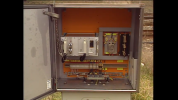
(photo shows a lineside cabinet which is open and so you can see the encoder, mains filter, various resistors, fuse holders and cable terminals)
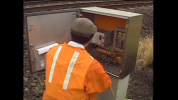
(photo shows a lineside cabinet which is open with a person looking inside)
Encoder showing the two parameter plugs:
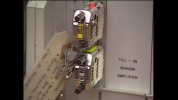
(photo shows a close up view of an encoder fitted with both of the two parameter plugs)
Signal beacon and the start of an in-fill loop:

(photo shows a beacon mounted on sleepers in the four foot, the dis-box for the start of the in-fill loop mounted on a sleeper next to the beacon and part of the single core cables that form the in-fill loop)

(photo shows another view of a beacon, with a person working on the beacon, directly behind the person you can see the original horizontal type dis-box for the cable to the beacon)
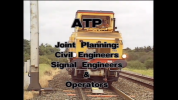
(photo shows another view of a signal beacon, here you can see where it is in relation to the signal, the post of which is on the left, also on the left you can see the dis-box for the cable to the beacon mounted in the ballast shoulder)
APTLITs

(photo shows some 2BA electrical terminals fitted with 2BA type APTLITs)
One wonders why this wasn't recognised...
The sizeable costs come from an estimate of fitting EVERY signal on the network and the costs of fitting EVERY single train.
How problematic has the lack of updates between beacons been? The cable loops are there to help with this in theory.
Did the pilot installations provide any particular insights, other than the perceived cost?
That's difficult to say. The pilot installations had a mix of signal beacon only, signal beacon and in-fill beacon or signal beacon and in-fill loop. The length of the loops varied. The positions of the in-fill beacons were carefully selected.
Drivers had to learn to drive differently. If a signal is showing green, it's no problem, the train can be driven as normal. If the signal is showing a double yellow or a single yellow and does not change aspect as the train approaches, the driver must keep the speed of the train within the braking curve so that the train can stop short of the (potentially unseen) red signal ahead. If the signal is red, the train has to stop short of the signal, then when it clears move forward so that the on-board computers can receive the message from the signal beacon, which will now reflect the current displayed aspect.
The limitations are, that if a signal steps up to a less restrictive aspect after the train has passed the previous signal, the driver has to continue to obey the braking curve as if the signal has not changed aspect, until either, the on-board computers have received a new message from either, an in-fill beacon, an in-fill loop or worst case, the signal beacon at the signal. This gives the impression that the train is being delayed unnecessarily. But how much delay, if any is caused depends on a number of factors, if the train is following yellows because of a slower train ahead, in practice, there may be very little lost time.
For this reason, the train operator was against using ATP. But attitudes changed after the Ladbroke Grove rail crash.

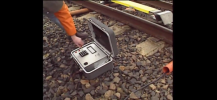
 Unfortunately it's been the extent of my knowledge, until this thread.
Unfortunately it's been the extent of my knowledge, until this thread.





